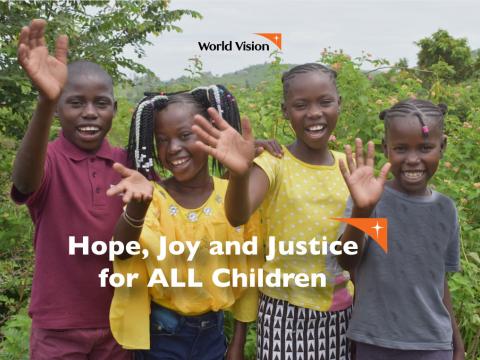Going Further to transform the lives of children in Kenya

By Lilian Dodzo, National Director, World Vision Kenya
Approximately 36 percent of the Kenyan population can be classified as monetary poor, based on recent government statistics from the 2020 Comprehensive Poverty Report.
On the other hand, about 53 percent can be considered as multidimensionally poor. These are people who are deprived in the realisation of at least three basic needs, services and rights that were analysed in the report. They included physical development, nutrition, health, education, water, sanitation and housing.
Despite being the youngest and most fragile of the society, children are the worst hit by both types of poverty. These challenges adversely affect their well-being, denying them the opportunity to fully enjoy their rights and attain their life dreams.
Through its new strategy (2021-2025), Going Further Together with Hope and Resilience for Children, World Vision Kenya is keen on addressing these challenges through the implementation of transformative development projects and child rights advocacy initiatives. These initiatives seek to contribute to the improved and sustained well-being of over eight million children in the country, as well as their families and communities.
We are deliberately seeking to increase our presence in fragile contexts. These include conflict prone areas, informal urban settlements and rural areas where large numbers of children are trapped in a cycle of desperation and poverty.
We carefully identified and chose the targeted children and priority areas through a national level census mapping survey. It disaggregated the different challenges affecting children in Kenya such as abusive or exploitative relationships, extreme deprivation of basic needs, serious discrimination, disability and catastrophic disasters.
As firm believers in an all-inclusive collaborative approach to development, our strategy is a product of collaborative efforts between the organisation and key stakeholders including children, community members, government bodies, faith leaders, civil society organisations and private sector players.
They all provided input into the strategy, with great insights into challenges affecting children as well as ways in which those problems could be solved through effective development strategies and partnerships.
We will be keen in working with all these partners as we support the government's development initiatives, which are aimed at enriching the lives of vulnerable children, families and communities in Kenya.
No organisation can do it alone. As the African proverb aptly says: “If you want to go fast, go alone; but if you want to go far, go together”. Therefore, if we are to go further together, we all need to join hands and advocate strongly for the improved well-being of children in Kenya.
The development and humanitarian landscape keeps changing. And as this happens, all players in the sector need to awaken to the new realities, challenges and opportunities resulting from the changes.
For instance, decreases in donor funding provide opportunities for Non-Governmental Organisations (NGOs) to embrace new funding models. Therefore, as we continue to work with our long-term external and multilateral donors, we will also be going further in our local resource mobilisation efforts, to increase our partnerships with local organisations and Kenyans so as to raise finances or get in-kind support that will help transform the lives of children in Kenya.
Calamities such as COVID-19 have also pushed NGOs to come up with innovative ways of sustaining their operations and continuing to bring transformative change to communities, irrespective of disruptions caused by unpredictable disasters.
This is why we are taking a bold step to invest in Information, Communication and Technology (ICT), which will also expand the reach and effectiveness of our development projects.
In all that we do, we will be striving for impact, success and sustainable change in communities. We are therefore focusing on evidence-based results derived from scientific research, through partnerships with research and academic institutions. Our goal is to bring hope, joy and justice for all children in Kenya.
Here is a brief video highlighting the focus areas of the new World Vision Kenya strategy.
Also, learn more about the new strategy HERE.